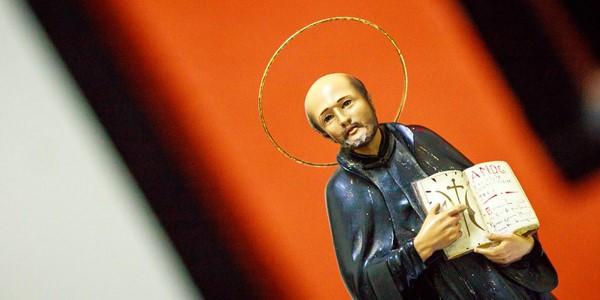‘Ignatius was clearly of the view that the biblical stories were potentially a source of life’, says Nicholas King SJ as he explores the way in which the founder of the Jesuits invites those who follow his spirituality to engage with the Bible. How do St Ignatius Loyola’s Spiritual Exercises help us to use our imaginations as we contemplate biblical narratives and thereby hear the God Who Speaks?
Catholics in England and Wales are being invited by their bishops to celebrate, live and share God’s Word through ‘The God Who Speaks’ initiative, and so it seems a good idea this year to celebrate the feast of St Ignatius by reflecting on how he uses the texts of Scripture (almost entirely the New Testament, and mainly gospels) in the Spiritual Exercises. Biblical scholars, even Jesuit biblical scholars, of a certain generation, sometimes feel a bit anxious about this sort of talk; but certainly Ignatius was a most attentive reader of the biblical text, and that is the first rule for those who would take the Bible seriously. For example, he tells us in his Autobiography,[1] at the time of his conversion, that he enjoyed ‘those books, and the thought came to him of briefly extracting some of the more essential elements from the life of Christ and of the saints; and so he set himself to write a book with great diligence…the words of Christ in red ink; and those of Our Lady in blue ink’. He is clearly finding a great deal of life in those narratives.
This leads to a further point, for Ignatius was clearly of the view that the biblical stories were potentially a source of life. A very high proportion of the Bible is narrative, and the point of narrative is that it invites the reader aboard; and the question is not ‘but did this really happen?’ so much as ‘where is the life in this story?’. An obvious example of this comes in the Exercises, where the retreatant is invited into ‘imaginative contemplation’, which is precisely a matter of allowing the ‘mysteries’ to exercise their power, and thereby bring the retreatant into life.
Look at the first two exercises of the Second Week, the incarnation and the birth of Jesus.[2] What is going on here is not exegesis or hermeneutics, but using the imagination to kindle the fire of life. The retreatant is invited to ‘recall the narrative’[3] of the event, and then enter more deeply into the story by attending to the ‘composition, seeing the place’. This creates a story which invites us in. When he turns to the birth of Jesus, Ignatius suggests some vivid details to engage our imagination. For example, the journey from Nazareth to Bethlehem is taken, ‘seated on a donkey, taking an ox with them’. This does not come from Luke’s gospel account, but from the imagination of St Francis of Assisi, who seems to have created the first Christmas crib. There is of course nothing wrong with imagination: Christian meditation on Isaiah 1:3 (‘an ox knows its owner, an ass its master’s crib’) is the source of the presence of ‘ox and ass’ at the Bethlehem manger. And the second century Proto-Gospel of James, which is itself an entirely lively and imaginative meditation on the scriptural text, is the first text to give Mary a donkey for the journey.[4]
In that meditation on the incarnation, Ignatius once again uses his imagination to give life to the text (though the Proto-Gospel of James is not the source of this particular detail) by producing a ‘servant-girl’[5] to accompany Joseph and Our Lady. The reason for this servant-girl now becomes clear, when Ignatius invites the retreatant to use her or his imagination to enter into the story and draw life from it, ‘by making myself into a poor little, unworthy little slave, watching them, contemplating them and serving them in their needs, as though I found myself present, with all possible reverence and respect. And afterwards to reflect in myself, to draw some profit in myself.’[6] Here we have clearly departed from the text, in order to find the life of the Spirit through the use of imagination.
Another excellent example of this freedom with regard to the text comes at the beginning of the Fourth Week. The first contemplation is ‘how Christ Our Lord appeared to Our Lady’.[7] Obviously Ignatius had no scripture text to work from here; and conceivably his secretary may have whispered that in his ear, for, on the second time he mentions it,[8] Ignatius adds (can we imagine, slightly irritably?), ‘even though it is not mentioned in Scripture, you can understand it as mentioned, given that he appeared to so many others. For the Scripture presumes that we have understanding, as it is written: “Are you also without understanding?”’ And this exercise, which has proved so powerful for many retreatants, is certainly an excellent example of imagination bringing life. For it invites us, in the contemplation of place, ‘to see the arrangement of … Our Lady’s place or house, looking in detail at its parts, likewise her room and prayer-place’. So, there is a great freedom here; but it is not disrespectful of the biblical text, only using it as a platform from which to find a greater prayerful depth.
What Ignatius is doing in all these examples is akin to what an artist in stained glass does: using the text of Scripture and employing imagination to go prayerfully beyond what is there to find in freedom what the Spirit might be inviting us to discern, and so find the life that lies between the lines of the text. In this context, it is worth observing how respectful Ignatius is of the biblical text when it comes to the ‘mysteries of the life of Christ Our Lord’.[9] Here he is offering ‘points for prayer’, and for the most part they follow the text of Scripture. An interesting exception to this is the story at Matthew 2:1-12, the narrative of the Magi, where these foreigners are twice described as ‘kings’[10]; Ignatius did not get this from Matthew (nor from the Proto-Gospel of James, for that matter), but it is not precisely unfaithful to the text, and was very likely part of the popular imagination of his contemporaries, perhaps fed by stained glass depictions of the story. The reader might reflect on what they are doing when they sing the words of the 19th century American carol, ‘We three kings of Orient are’; does it help them to go deeper into the mystery?
There are very few deviations from the text in these mysteries; when he touches on the visit of Our Lady and Joseph to Bethlehem, Ignatius indicates that this was to ‘acknowledge his subjection to Caesar’,[11] a notion which is not to be found in the text, not even the Vulgate, although you might say that this is the clear implication. The reader will notice about Ignatius’s use of scripture here that he gives simply a brief quotation, to allow the retreatant the freedom to be led in prayer by the Spirit. Even when he says that Jesus ‘practices the trade of a carpenter’,[12] he is careful to give an appropriate citation from Mark.
There is one episode which, like the apparition to his mother after the resurrection, is not in the gospel text, namely Jesus’s ‘farewell to the blessed Mother’.[13] There is no doctrinal problem here, but there is the possibility of a great deal of life for the contemplation of the retreatant who might gain a good deal from imagining the pain of the goodbyes of mother and son; and it is only a tiny detail in the context of the meditation as a whole.
When it comes to the Exercise on Jesus’s temptations,[14] Ignatius has the three temptations that you find in Matthew and Luke, as opposed to Mark’s scantier account. He records them in the order followed by Matthew, as opposed to Luke (and it is noticeable that he has a preference for Matthew, as a general rule), even though here he mentions Luke first.
There is an interesting example of this attention to the text where Ignatius distinguishes three types of calling of the first disciples[15]: there is ‘Saint Peter and Saint Andrew’ (John 1:40-42); then a different sort of call ‘as St Luke says in chapter 5’, with the intention of going back to possess what they had left; then ‘thirdly, to follow Christ Our Lord for ever’, where he cites Matthew 4 and Mark 1. Ignatius clearly has in mind here that there are ways of inviting the retreatant to go deeper into the vocation, but he is not advocating for any particular one of them; and, quite clearly, he is reading the gospel text most attentively. Interestingly, between ‘three times’ and ‘were called’, Ignatius has written ‘it seems that’, so he or a secretary have seen the point of being careful about what the Scripture says.
You can see something of the same at Exercises §282 and §286, where Ignatius sees two different stories: Luke 7:36-50, the anointing of Jesus’s feet, though Ignatius ascribes this to ‘the Magdalen’; and ‘the supper at Bethany’ (Matthew 26:6-10), where the woman is once more identified as ‘Mary’, though this identification is only made in John’s Gospel. This is perfectly defensible, and there are contemporary scholars who see these as two different stories.
Ignatius’s attentiveness to the text is also on display where he puts together the two different accounts of the Last Supper, in Matthew 26:20-30 and John 13:1-30.[16] The first of these is what is often called the ‘institution narrative’, and the second is the ‘washing of the feet’, where John does something rather different. Ignatius, however, is reading the text very carefully. Many modern scholars would say that he is quite right to link those two events, that the fourth evangelist is well aware of the synoptic version, so the addition of Jesus performing this strikingly servile task as a way of interpreting what the Eucharist is about springs from a most sensitive and attentive reading of what is before him.
It must also be said that Ignatius knows the difference between various different texts, for example that in Gethsemane Luke, in at least some significant manuscripts, has the detail that ‘his sweat became like drops of blood going down onto the ground’.[17] Ignatius includes some details that are found only in Luke (Jesus being sent by Pilate to Herod, and Pilate and Herod becoming friends in consequence).[18] Likewise, he takes from Matthew the detail about the placing of the guard.[19] And we should observe that he always gives biblical references.
What, then, about the ‘apparition to Joseph of Arimathea’, which appears slightly unexpectedly.[20] It is not in the gospels, of course, but Ignatius might argue that the apparitions were always to those who were his disciples, and clearly Joseph comes into that category. Ignatius is evidently aware of the difficulty, for he adds ‘as is piously meditated and read in the life of the saints’, a phrase that he has added after crossing out ‘says the gospel of Nicodemus’. The words to Thomas, too, from John 20: ‘put your finger here’ have the added words ‘and see the truth’.[21] This is not in John, but has the merit of being a thoroughly Johannine formulation.
******
Ignatius is admirably respectful of the text of Scripture. His aim in suggesting texts for the different ‘mysteries’ of the Exercises is not a matter of loading the dice; the retreatant is simply invited to use various statements, normally single sentences, as a basis for prayer. Ignatius is aware of differences between the various gospel authors, and knows the text very well indeed. He is an admirable model for us as we try to listen out for the voice of the God who speaks.
Nicholas King SJ is a Tutor and Fellow in New Testament Studies at Campion Hall, University of Oxford.
[1] Autobiografia §11.
[2] Exx §101-119.
[3] See St Ignatius of Loyola, Personal Writings (ed. Joseph Munitiz and Philip Endean); the Spanish is traer la historia.
[4] See Proto-Gospel of James 17.
[5] una ancila (Exx §111).
[6] Exx §114.
[7] Exx §218.
[8] Exx §299.
[9] Exx §261- 312.
[10] Exx §267.
[11] Exx §264.
[12] Exx §271, Mark 6:3.
[13] Exx §273.
[14] Exx §274.
[15] Exx §275.
[16] Exx §289.
[17] Luke 22:44.
[18] Exx §293-295.
[19] Matthew 27:62-66, Exx §298.
[20] Exx §310.
[21] Exx §305.






